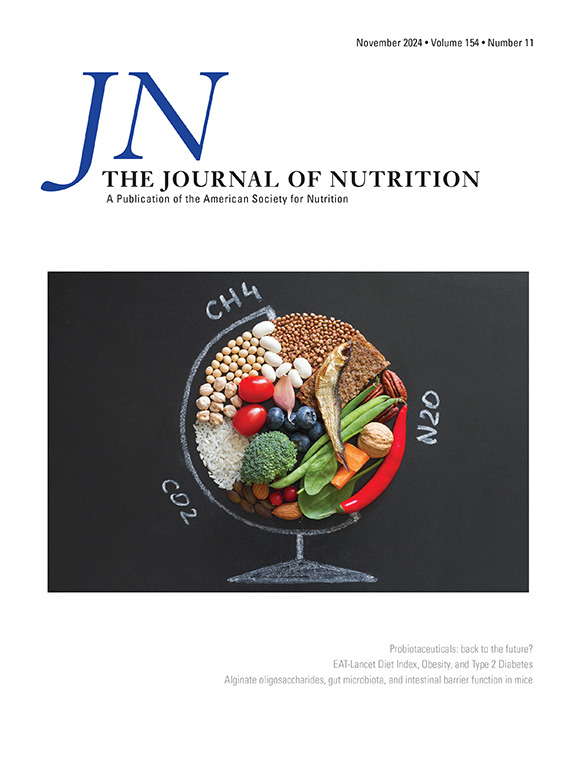Diet Quality Trajectories From Infancy to Young Adulthood: The Special Turku Coronary Risk Factor Intervention Project (STRIP) Study
IF 3.7
3区 医学
Q2 NUTRITION & DIETETICS
引用次数: 0
Abstract
Background
Stability in dietary habits has been observed during childhood and adolescence, but their stability from infancy to adulthood is less known.
Objectives
Our aim was to identify latent diet quality trajectories from age 1 to 18 y and to examine their association with diet quality at age 26 y.
Methods
The study included 620 participants from the Special Turku Coronary Risk Factor Intervention Project, initiated in infancy. Food and nutrient intake were assessed annually from age 1 to 18 y and again at age 26 y using food records. A food-based diet score (range: 0–33) was calculated to indicate diet quality. Group-based modeling was used to model trajectories of diet quality between the ages of 1 and 18 y. Logistic regression analysis examined associations of childhood sociodemographic characteristics with diet trajectories. Linear regression analyses investigated associations between the observed developmental diet quality trajectory groups and diet quality at age 26 y, adjusted for adulthood sociodemographic characteristics.
Results
From age 1 to 18 y, 5 diet quality trajectory groups were identified: low (19% of participants), decreasing (25%), increasing (15%), intermediate (31%), and high (10%). Throughout the follow-up period, the diet score remained at 20–22 in the high diet quality trajectory group and at 11–13 in the low diet quality trajectory group. The diet quality trajectory groups predicted diet quality at age 26 y (P < 0.001). The adjusted mean difference in adulthood diet score between the low and high diet trajectory groups was 3.6 (95% CI: 1.5, 5.7). Notably, participants in the intervention group had higher scores than controls across all trajectories and throughout the entire follow-up period.
Conclusions
The 5 distinct diet quality trajectory groups from infancy to adulthood highlight a clear difference between the highest and lowest diet quality groups. The findings suggest that dietary habits established in early childhood remain moderately stable into early adulthood.
从婴儿期到青年期的饮食质量轨迹:STRIP研究。
背景:饮食习惯在儿童期和青春期的稳定性已被观察到,但其从婴儿期到成年期的稳定性尚不清楚。目的:我们的目的是确定从1岁到18岁的潜在饮食质量轨迹,并检查其与26岁时饮食质量的关系。方法:该研究包括来自图尔库特殊冠状动脉危险因素干预项目(STRIP)的620名参与者,该项目始于婴儿期。从1岁到18岁,每年评估一次食物和营养摄入量,并在26岁时再次使用食物记录。以食物为基础的饮食评分(范围0-33)来表示饮食质量。采用分组模型对1 ~ 18岁儿童的饮食质量轨迹进行建模。Logistic回归分析检验了儿童社会人口学特征与饮食轨迹的关系。线性回归分析调查了观察到的发育饮食质量轨迹组与26岁时饮食质量之间的关系,并根据成年社会人口统计学特征进行了调整。结果:从1岁到18岁,确定了五个饮食质量轨迹组:低(19%),降低(25%),增加(15%),中等(31%)和高(10%)。在整个随访期间,高质量饮食组的饮食评分保持在20-22分,低质量饮食组的饮食评分保持在11-13分。结论:该研究确定了从婴儿期到成年期的五个不同的饮食质量轨迹组,突出了饮食质量最高和最低组之间的明显差异。研究结果表明,儿童早期形成的饮食习惯在成年早期保持适度稳定。
本文章由计算机程序翻译,如有差异,请以英文原文为准。
求助全文
约1分钟内获得全文
求助全文
来源期刊

Journal of Nutrition
医学-营养学
CiteScore
7.60
自引率
4.80%
发文量
260
审稿时长
39 days
期刊介绍:
The Journal of Nutrition (JN/J Nutr) publishes peer-reviewed original research papers covering all aspects of experimental nutrition in humans and other animal species; special articles such as reviews and biographies of prominent nutrition scientists; and issues, opinions, and commentaries on controversial issues in nutrition. Supplements are frequently published to provide extended discussion of topics of special interest.
 求助内容:
求助内容: 应助结果提醒方式:
应助结果提醒方式:


